Land Use Suitability Model for Grapevine (Vitis vinifera L.) Cultivation Using the Best Worst Method: A Case Study from Ankara/Türkiye
Abstract
:1. Introduction
2. Materials and Methods
2.1. Study Area
2.2. Model Development
2.2.1. Data Sources
2.2.2. Description of Evaluation Criteria and Constraints
2.3. Meteorological Factors
- (a)
- Growing degree days (GDD): GDD, a widely used agro-climatic index, is the sum of temperatures above 10 °C during the development period (between 1 April and 31 October). It starts to develop when the daily average temperature exceeds +10 °C, and continues to develop until the average temperature drops below this value in the autumn. This parameter was used to determine the suitability of the region for grapevines. For grapevine cultivation to be carried out in an economic sense, the GDD must be at least 900 days. Values higher than 2700 were considered too hot for wine grape production [54,64,65].
- (b)
- Growing season precipitation (mm): During the growth period (between 1 April and 31 October), precipitation is important. Precipitation is required for growth. Irrigation is not required in areas with 600 mm of precipitation. However, irrigation increases the success at 300–600 mm of precipitation. Irrigation is necessary at 300 mm and below.
- (c)
- Maturation season precipitation (mm): Precipitation can increase the chances of fungal growth and reduce quality at the stages of fruit growth and maturation. Precipitation greater than 900 mm can lead to fungal diseases.
- (d)
- Growing season average temperature (°C): Below <13 °C is considered very cold, and above 21 °C is considered very hot [66].
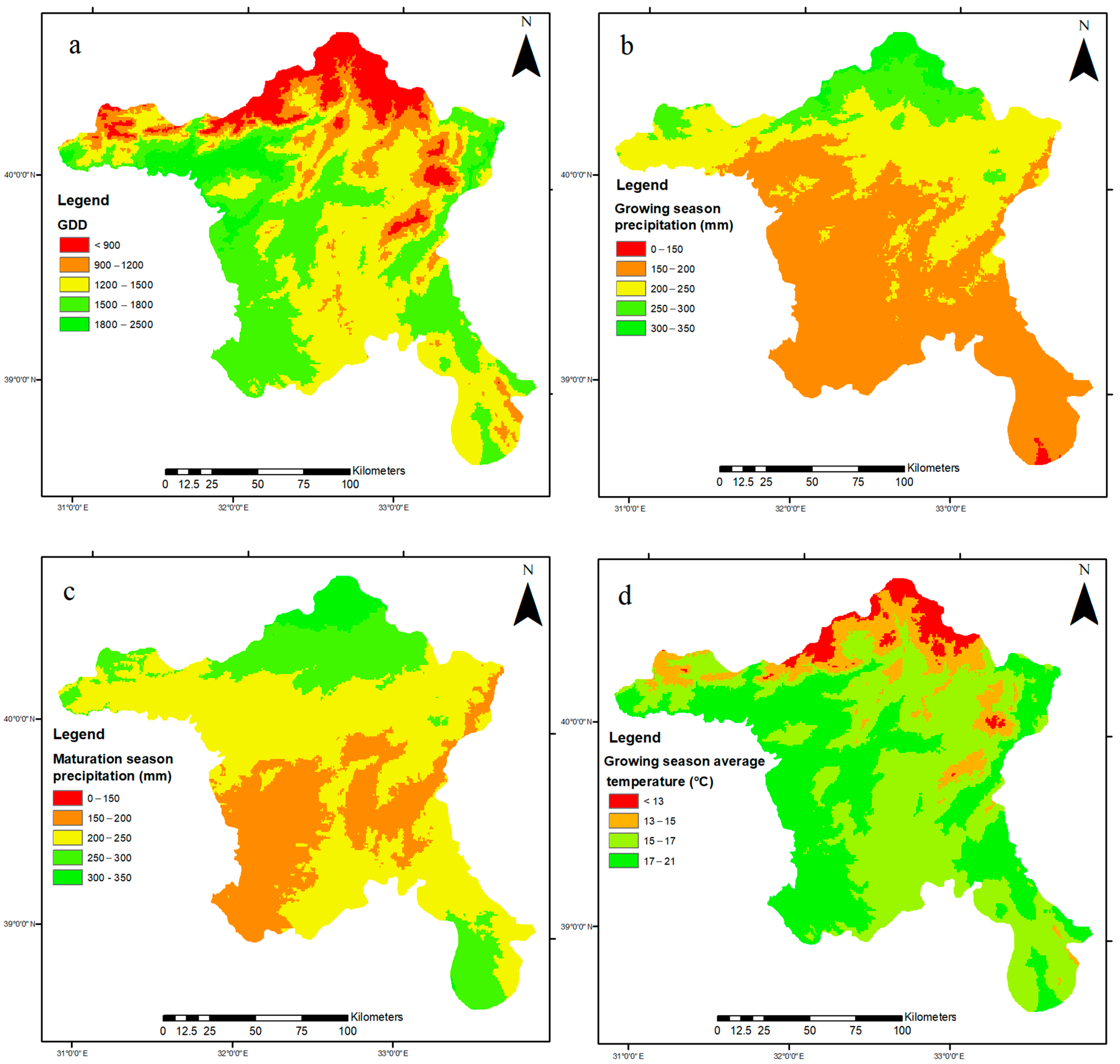
2.4. Topographic Factors
- (a)
- Altitude: The mesoclimate properties of a grapevine are mostly affected by altitude (Figure 4). As a result, atmospheric pressure and temperature decreases, and solar radiation increases. Accordingly, a height of 2500–3000 m in hot regions, and 300 m in cold regions are the limit values for grapevines. Generally, altitudes of 1500–2000 m are accepted as the optimum heights for grapevine, as in Türkiye [67,68,69,70].
- (b)
- Slope and aspect: In spring and autumn, slope and aspect affect the solar and surface radiation balance. Sloping terrain affects the flow of cold air, and is therefore an important factor in frost events. Because sloping lands hold less water and produce high-quality products, they are important for grapevines. Moderate slopes (5–15%) are considered optimum for wine grape growth in the suitability analysis. In the Northern Hemisphere, south-facing slopes provide heat accumulation through exposure to maximum sunlight. This affects the fruit maturation and quality. The appropriate slopes that should be selected when establishing a grapevine are those facing south, south–east, and south–west directions [45,46,67].
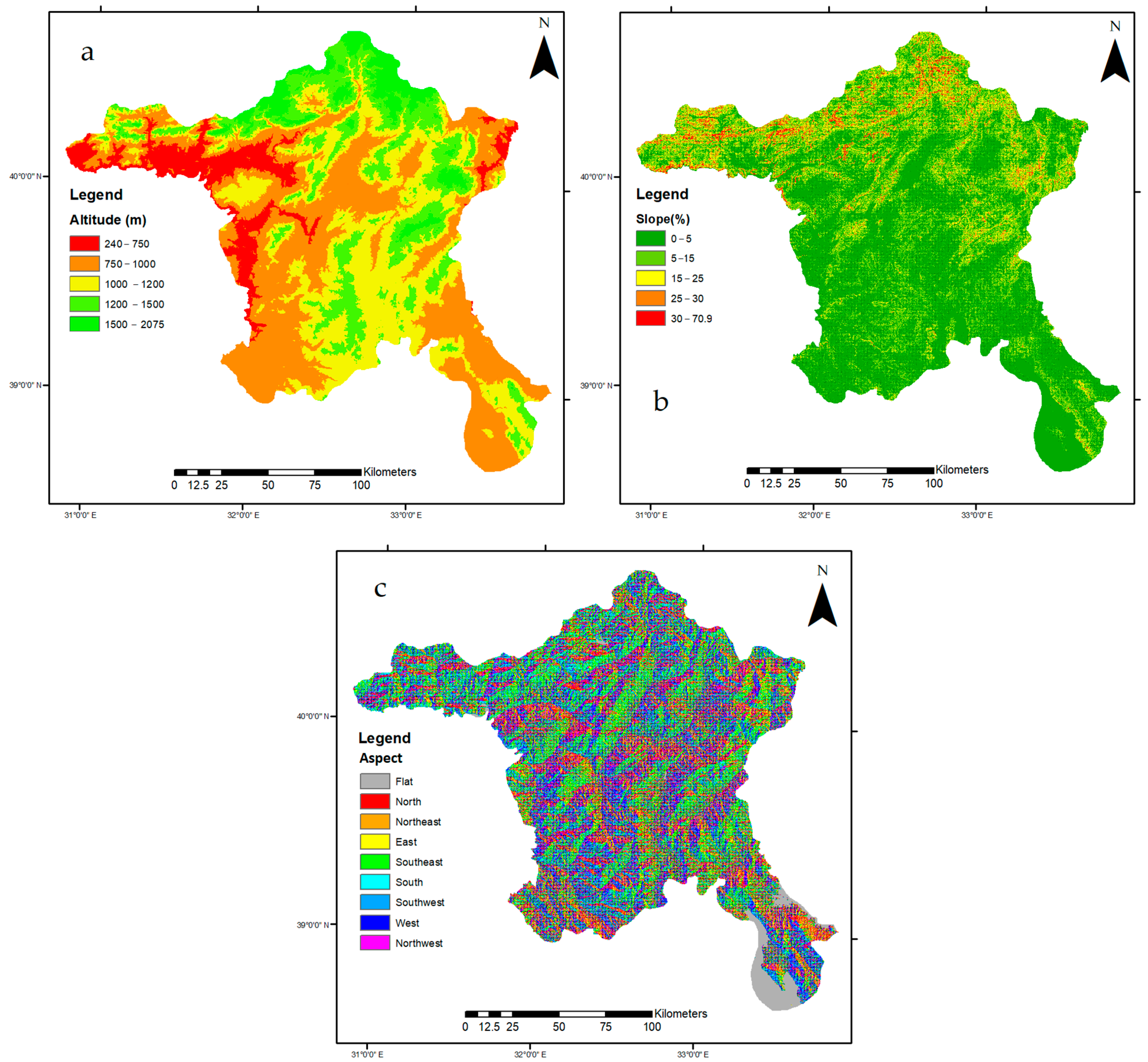
2.5. Soil Factor
- (a)
- Soil depth: Soil depth is an important criterion for grapevines. The ideal soil for grapevines can be protected. Unlimited soil drainage to a depth of 2–3 m is recommended for most grapevines [40]. Soil depth refers to the maximum depth at which the roots of the vine freely, without obstacles, penetrate the soil, providing plants with physical support, and conditions for the absorption of water and nutrients. In many studies, the soil depth for the production of Vitis vinifera has been stated to be very good above 90–100 cm and unsuitable below 30–40 cm [47,71].
- (b)
- Land use capability: This classification is mostly used in land use plan studies. In this classification, all land-related data are combined to obtain a combination of agricultural use and conservation measures that will provide the most intensive and appropriate agricultural use of the land without causing soil degradation and erosion. The lands are numbered between classes I and VIII according to the land use capability calculated using various methods. Class I lands are the most valuable lands, which can be cultivated in the most productive, easy, and economical way. Class VIII lands are not suitable for agriculture but can create a natural habitat or be used by people in an urban sense [72]. The land in the study area was divided into eight groups according to their land-use capabilities. In the study area, there was land from class I to class VIII.
- (c)
- Soil texture: The purpose of classifying soils, which vary from place to place, each with its own characteristics, is to help us remember the important characteristics of soils, to combine our knowledge about soils, to see the relations of soils with each other and with the environment, and to develop information about their properties and suitability for use [72]. Knowing the major soil group the soil belongs to makes it easy to predict the performance of the soil. The soil groups in the Ankara Province are alluvial, chestnut, brown, brown forest, non-calcareous brown forest, non-calcareous brown soils, reddish brown, and colluvial soils (Figure 5). Grapevines usually grow in loamy soil, but they can adapt to many soil types, such as sandy clay, clayey–limy, stony, and loamy. Soils rich in gravel, sandy clay, and organic materials are suitable for vineyard cultivation.
2.6. BWM Weights of the Preferred Criteria
- Step 1: In the first step, the criteria {C1, C2, ……, Cn} to be used in the decision-making problem should be determined.
- Step 2: Determine the most important criterion (B) and least important criterion (W).
- Step 3: The rate of preference for the most important (B) criteria over other criteria is determine using a number between 1 and 9 (1 = equally important, 3 = moderately important, 5 = highly important, 7 = much more important, 9 = extremely important). Consequently, the following vector, named best–others (AB), progressing from the best to the others, is obtained:
- Step 4: The rate of preference of the least important (worst) criteria over other criteria is determined by using a number between 1 and 9. As a result, the following vector, named others–worst (Aw) progressing from the others to worst is reached.
- Step 5: With the model shown in Equation (3), the optimum weights of the criteria (w1 × w2 ×…× wn) and the consistency indicator (ξL) are calculated. If the consistency indicator is close to “0”, it indicates high consistency [74].
3. Results and Discussion
4. Conclusions
Author Contributions
Funding
Institutional Review Board Statement
Informed Consent Statement
Data Availability Statement
Conflicts of Interest
References
- Kodirov, R.B.; Temirov, Z.A. Forecasts and demographic development of the population of Fergana Valley regions of Uzbekistan until 2040. J. Geol. Geogr. Geoecol. 2021, 30, 491–499. [Google Scholar] [CrossRef]
- Poštek, A.; Kisić, I.; Cerjak, M.; Brezinščak, L. Social aspect of urban agriculture with examples from Croatia. J. Central Eur. Agric. 2021, 22, 881–891. [Google Scholar] [CrossRef]
- Tal, A. Making conventional agriculture environmentally friendly: Moving beyond the glorification of organic agriculture and the demonization of conventional agriculture. Sustainability 2018, 10, 1078. [Google Scholar] [CrossRef]
- Svircev, A.; Roach, D.; Castle, A. Framing the future with bacteriophages in agriculture. Viruses 2018, 10, 218. [Google Scholar] [CrossRef] [PubMed]
- Uyan, M.; Tongur, V.; Ertunc, E. Comparison of different optimization based land reallocation models. Comput. Electron. Agric. 2020, 173, 105449. [Google Scholar] [CrossRef]
- Ertunç, E.; Uyan, M.; Tongur, V. Land reallocation model with simulated annealing algorithm. Surv. Rev. 2021, 53, 383–389. [Google Scholar] [CrossRef]
- Vincent, D.R.; Deepa, N.; Elavarasan, D.; Srinivasan, K.; Chauhdary, S.H.; Iwendi, C. Sensors Driven AI-Based Agriculture Recommendation Model for Assessing Land Suitability. Sensors 2019, 19, 3667. [Google Scholar] [CrossRef] [PubMed]
- Tağıl, Ş. Assessment of Agricultural Land-Use Suitability Levels in the Gulf of Edremit. J. Geogr. 2020, 40, 135–147. [Google Scholar]
- Noszczyk, T.; Rutkowska, A.; Hernik, J. Determining Changes in Land Use Structure in Małopolska Using Statistical Methods. Pol. J. Environ. Stud. 2017, 26, 211–220. [Google Scholar] [CrossRef]
- Dewan, A.M.; Kabir, H.; Nahar, K.; Rahman, Z. Urbanisation and environmental degradation in Dhaka Metropolitan Area of Bangladesh. Int. J. Environ. Sustain. Dev. 2012, 11, 118. [Google Scholar] [CrossRef]
- Zhong, C.; Guo, H.; Swan, I.; Gao, P.; Yao, Q.; Li, H. Evaluating trends, profits, and risks of global cities in recent urban expansion for advancing sustainable development. Habitat Int. 2023, 138, 102869. [Google Scholar] [CrossRef]
- Janus, J.; Bożek, P.; Taszakowski, J.; Doroż, A. Decaying villages in the centre of Europe with no population decline: Long-term analysis using historical aerial images and remote sensing data. Habitat Int. 2022, 121, 102520. [Google Scholar] [CrossRef]
- Raza, A.; Razzaq, A.; Mehmood, S.S.; Zou, X.; Zhang, X.; Lv, Y.; Xu, J. Impact of Climate Change on Crops Adaptation and Strategies to Tackle Its Outcome: A Review. Plants 2019, 8, 34. [Google Scholar] [CrossRef] [PubMed]
- Corwin, D.L. Climate change impacts on soil salinity in agricultural areas. Eur. J. Soil Sci. 2021, 72, 842–862 . [Google Scholar] [CrossRef]
- Morales, F.F.; de Vries, W.T. Establishment of Natural Hazards Mapping Criteria Using Analytic Hierarchy Process (AHP). Front. Sustain. 2021, 2, 667105. [Google Scholar] [CrossRef]
- Du, Y.; Cui, B.; Zhang, Q.; Wang, Z.; Sun, J.; Niu, W. Effects of manure fertilizer on crop yield and soil properties in China: A meta-analysis. CATENA 2020, 193, 104617. [Google Scholar] [CrossRef]
- Orhan, O. Land suitability determination for citrus cultivation using a GIS-based multi-criteria analysis in Mersin, Turkey. Comput. Electron. Agric. 2021, 190, 106433. [Google Scholar] [CrossRef]
- Akpoti, K.; Kabo-Bah, A.T.; Zwart, S.J. Agricultural land suitability analysis: State-of-the-art and outlooks for integration of climate change analysis. Agric. Syst. 2019, 173, 172–208. [Google Scholar] [CrossRef]
- Fan, M.; Kang, M.; Wang, X.; Hua, J.; He, C.; Wang, F. Parallel crop planning based on price forecast. Int. J. Intell. Syst. 2022, 37, 4772–4793. [Google Scholar] [CrossRef]
- Maleki, F.; Kazemi, H.; Siahmarguee, A.; Kamkar, B. Development of a land use suitability model for saffron (Crocus sativus L.) cultivation by multi-criteria evaluation and spatial analysis. Ecol. Eng. 2017, 106, 140–153. [Google Scholar] [CrossRef]
- FAO. A Framework for Land Evaluation; FAO Soils Bulletin: Rome, Italy, 1976; p. 32. [Google Scholar]
- Tercan, E.; Dereli, M.A. Development of a land suitability model for citrus cultivation using GIS and multi-criteria assessment techniques in Antalya province of Turkey. Ecol. Indic. 2020, 117, 106549. [Google Scholar] [CrossRef]
- Janus, J.; Taszakowski, J. Spatial differentiation of indicators presenting selected barriers in the productivity of agricultural areas: A regional approach to setting land consolidation priorities. Ecol. Indic. 2018, 93, 718–729. [Google Scholar] [CrossRef]
- Kazemi, H.; Akinci, H. A land use suitability model for rainfed farming by Multi-criteria Decision-making Analysis (MCDA) and Geographic Information System (GIS). Ecol. Eng. 2018, 116, 1–6. [Google Scholar] [CrossRef]
- Wójcik-Leń, J.; Leń, P.; Sobolewska-Mikulska, K. The proposed algorithm for identifying agricultural problem areas for the needs of their reasonable management under land consolidation works. Comput. Electron. Agric. 2018, 152, 333–339. [Google Scholar] [CrossRef]
- Uyan, M. Arazi Düzenlemesi Çalışmalarında Mekânsal Karar Destek Sistemleri Kurulumu ve Uygulaması. Ph.D. Thesis, Selcuk University, Graduate School of Natural Sciences, Konya, Turkey, 2011. (In Turkish). [Google Scholar]
- Kahsay, A.; Haile, M.; Gebresamuel, G.; Mohammed, M. GIS-based multi-criteria model for land suitability evaluation of rainfed teff crop production in degraded semi-arid highlands of Northern Ethiopia. Model. Earth Syst. Environ. 2018, 4, 1467–1486. [Google Scholar] [CrossRef]
- Mohamed, A.H.; Shendi, M.M.; Awadalla, A.A.; Mahmoud, A.G.; Semida, W.M. Land suitability modeling for newly reclaimed area using GIS-based multi-criteria decision analysis. Environ. Monit. Assess. 2019, 191, 535. [Google Scholar] [CrossRef] [PubMed]
- Šiljeg, A.; Jurišić, M.; Radočaj, D.; Videković, M. Suitability modeling of agricultural land for barley cultivation using the multicriteria GIS analysis. Poljoprivreda 2020, 26, 40–47. [Google Scholar] [CrossRef]
- Ozsahin, E.; Ozdes, M. Agricultural land suitability assessment for agricultural productivity based on GIS modeling and multi-criteria decision analysis: The case of Tekirdağ province. Environ. Monit. Assess. 2022, 194, 41. [Google Scholar] [CrossRef]
- Musakwa, W. Identifying land suitable for agricultural land reform using GIS-MCDA in South Africa. Environ. Dev. Sustain. 2018, 20, 2281–2299. [Google Scholar] [CrossRef]
- Wójcik-Leń, J.; Postek, P.; Stręk, Ż.; Leń, P. Proposed algorithm for the identification of land for consolidation with regard to spatial variability of soil quality. Land Use Policy 2020, 94, 104570. [Google Scholar] [CrossRef]
- Wotlolan, D.L.; Lowry, J.H.; Wales, N.A.; Glencross, K. Land suitability evaluation for multiple crop agroforestry planning using GIS and multi-criteria decision analysis: A case study in Fiji. Agrofor. Syst. 2021, 95, 1519–1532. [Google Scholar] [CrossRef]
- Seyedmohammadi, J.; Sarmadian, F.; Jafarzadeh, A.A.; McDowell, R.W. Development of a model using matter element, AHP and GIS techniques to assess the suitability of land for agriculture. Geoderma 2019, 352, 80–95. [Google Scholar] [CrossRef]
- Ustaoglu, E.; Sisman, S.; Aydınoglu, A. Determining agricultural suitable land in peri-urban geography using GIS and Multi Criteria Decision Analysis (MCDA) techniques. Ecol. Model. 2021, 455, 109610. [Google Scholar] [CrossRef]
- Šiljeg, A.; Cavrić, B.; Šiljeg, S.; Marić, I.; Barada, M. Land suitability zoning for ecotourism planning and development of Dikgatlhong Dam, Botswana. Geogr. Pannon. 2019, 23, 76–86. [Google Scholar] [CrossRef]
- Kheybari, S.; Javdanmehr, M.; Rezaie, F.M.; Rezaei, J. Corn cultivation location selection for bioethanol production: An application of BWM and extended PROMETHEE II. Energy 2021, 228, 120593. [Google Scholar] [CrossRef]
- Deng, F.; Li, X.; Wang, H.; Zhang, M.; Li, R.; Li, X. GIS-based assessment of land suitability for alfalfa cultivation: A case study in the dry continental steppes of northern China. Span. J. Agric. Res. 2014, 12, 364–375. [Google Scholar] [CrossRef]
- Mendas, A.; Delali, A. Integration of Multi Criteria Decision Analysis in GIS to develop land suitability for agriculture: Application to durum wheat cultivation in the region of Mleta in Algeria. Comput. Electron. Agric. 2012, 83, 117–126. [Google Scholar] [CrossRef]
- Everest, T. Suitable site selection for pistachio (Pistacia vera) by using GIS and multi-criteria decision analyses (a case study in Turkey). Environ. Dev. Sustain. 2021, 23, 7686–7705. [Google Scholar] [CrossRef]
- Selim, S.; Koc-San, D.; Selim, C.; San, B.T. Site selection for avocado cultivation using GIS and multi-criteria decision analyses: Case study of Antalya, Turkey. Comput. Electron. Agric. 2018, 154, 450–459. [Google Scholar] [CrossRef]
- Zabihi, H.; Alizadeh, M.; Langat, P.K.; Karami, M.; Shahabi, H.; Ahmad, A.; Said, M.N.; Lee, S. GIS Multi-Criteria Analysis by Ordered Weighted Averaging (OWA): Toward an Integrated Citrus Management Strategy. Sustainability 2019, 11, 1009. [Google Scholar] [CrossRef]
- Seyedmohammadi, J.; Sarmadian, F.; Jafarzadeh, A.A.; Ghorbani, M.A.; Shahbazi, F. Application of SAW, TOPSIS and fuzzy TOPSIS models in cultivation priority planning for maize, rapeseed and soybean crops. Geoderma 2018, 310, 178–190. [Google Scholar] [CrossRef]
- Doan, M.N.T.; Dao, C.T.; Nguyen, N.T.; Nguyen, H.T.T.; Tran, H.L.T.; Le, S.T.; Van Vu, M. Research on the Potential Environmental Zonation of Red Flesh Dragon Fruit in Vinh Phuc Province. In From Science to Society; Springer: Cham, Switzerland, 2018; pp. 13–24. [Google Scholar]
- Badr, G.; Hoogenboom, G.; Moyer, M.; Keller, M.; Rupp, R.; Davenport, J. Spatial suitability assessment for vineyard site selection based on fuzzy logic. Precis. Agric. 2018, 19, 1027–1048. [Google Scholar] [CrossRef]
- Wanyama, D.; Bunting, E.L.; Goodwin, R.; Weil, N.; Sabbatini, P.; Andresen, J.A. Modeling Land Suitability for Vitis vinifera in Michigan Using Advanced Geospatial Data and Methods. Atmosphere 2020, 11, 339. [Google Scholar] [CrossRef]
- Alsafadi, K.; Mohammed, S.; Habib, H.; Kiwan, S.; Hennawi, S.; Sharaf, M. An integration of bioclimatic, soil, and topographic indicators for viticulture suitability using multi-criteria evaluation: A case study in the Western slopes of Jabal Al Arab—Syria. Geocarto Int. 2020, 35, 1466–1488. [Google Scholar] [CrossRef]
- Bunting, E.L.; Wanyama, D.; Goodwin, R.; Weil, N.; Sabbatini, P.; Andresen, J. Vitis vinifera Production in Michigan: Factors and Trends Driving Cultivation Patterns. Front. Plant Sci. 2021, 12, 704690. [Google Scholar] [CrossRef] [PubMed]
- Cislaghi, A.; Bordoni, M.; Meisina, C.; Bischetti, G.B. Soil reinforcement provided by the root system of grapevines: Quantification and spatial variability. Ecol. Eng. 2017, 109, 169–185. [Google Scholar] [CrossRef]
- Capó-Bauçà, S.; Marqués, A.; Llopis-Vidal, N.; Bota, J.; Baraza, E. Long-term establishment of natural green cover provides agroecosystem services by improving soil quality in a Mediterranean vineyard. Ecol. Eng. 2019, 127, 285–291. [Google Scholar] [CrossRef]
- Jovanović-Cvetković, T.; Sredojević, M.; Natić, M.; Grbić, R.; Akšić, M.F.; Ercisli, S.; Cvetković, M. Exploration and Comparison of the Behavior of Some Indigenous and International Varieties (Vitis vinifera L.) Grown in Climatic Conditions of Herzegovina: The Influence of Variety and Vintage on Physico-Chemical Characteristics of Grapes. Plants 2023, 12, 695. [Google Scholar] [CrossRef]
- Piña-Rey, A.; Ribeiro, H.; Fernández-González, M.; Abreu, I.; Rodríguez-Rajo, F.J. Phenological Model Predicting Budding and Flowering Dates of Four Vitis vinifera L. Cultivars Cultivated in DO. Ribeiro (North-West Spain). Plants 2021, 10, 502. [Google Scholar] [CrossRef]
- Parker, A.K.; de Cortázar-Atauri, I.G.; Gény, L.; Spring, J.L.; Destrac, A.; Schultz, H.; Molitor, D.; Lacombe, T.; Graça, A.; Monamy, C.; et al. Temperature-based grapevine sugar ripeness modelling for a wide range of Vitis vinifera L. cultivars. Agric. For. Meteorol. 2020, 285, 107902. [Google Scholar] [CrossRef]
- Ateş, F.; Uysal, H.; Merken, Ö.; Çetinkaya, Ö.Ü.N.; Eşitken, A.; Altındişli, A. Organik üzüm yetiştiriciliği. In TAGEM; Atatürk Horticultural Central Research Institute: Yalova, Türkiye, 2021; No 107. (In Turkish) [Google Scholar]
- Candar, S.; Uysal, T.; Ayaz, A.; Akdemir, U.; Korkutal, I.; Bahar, E. Viticulture Tradition in Turkey. Tekirdag Vitic. Res. Inst. 2021, 1, 39–54. [Google Scholar] [CrossRef]
- Ribeiro, J.D.; Ribeiro, D.C.; Duarte, J.S. A Legacy of Grape: A Socio-Cultural and Spatial Analysis of Ankara’s Wine Production History. J. Ank. Stud. 2020, 8, 215–251. [Google Scholar] [CrossRef]
- Kheybari, S.; Ishizaka, A. The behavioural best-worst method. Expert Syst. Appl. 2022, 209, 118265. [Google Scholar] [CrossRef]
- TOB. Ankara İli Tarımsal Yatırım Rehberi. 2015. Available online: https://ankara.tarimorman.gov.tr/Belgeler/pdf/yatirimrehberi.pdf (accessed on 17 January 2023). (In Turkish)
- Arab, S.T.; Salari, T.; Noguchi, R.; Ahamed, T. Land Suitability Analysis for Grape (Vitis vinifera L.) Production Using Satellite Remote Sensing, GIS, and Analytical Hierarchy Process. In Remote Sensing Application: Regional Perspectives in Agriculture and Forestry; Springer Nature: Singapore, 2022; pp. 149–184. [Google Scholar]
- Kim, H.; Koo, K.A.; Shim, K.M. The maximum limiting characteristic method-based land suitability assessment for peaches (Prunus persica) and grapes (Vitis vinifera L.) using rasterized data of soil and climate on agricultural land in South Korea. Korean J. Agric. For. Meteorol. 2019, 21, 286–296. [Google Scholar]
- Salata, S.; Ozkavaf-Senalp, S.; Velibeyoğlu, K.; Elburz, Z. Land Suitability Analysis for Vineyard Cultivation in the Izmir Metropolitan Area. Land 2022, 11, 416. [Google Scholar] [CrossRef]
- Tutić, D.; Štanfel, M.; Horvat, M.T. Multi-Criteria Land Evaluation of Suitability for the Sport of Foot Orienteering: A Case Study of Croatia and Slovenia. ISPRS Int. J. Geo-Inf. 2018, 7, 227. [Google Scholar] [CrossRef]
- Bilgilioğlu, S.S. Land suitability assessment for Olive cultivation using GIS and multi-criteria decision-making in Mersin City, Turkey. Arab. J. Geosci. 2021, 14, 2434. [Google Scholar] [CrossRef]
- Ortega-Farias, S.; Riveros-Burgos, C. Modeling phenology of four grapevine cultivars (Vitis vinifera L.) in Mediterranean climate conditions. Sci. Hortic. 2019, 250, 38–44. [Google Scholar] [CrossRef]
- Charalampopoulos, I.; Polychroni, I.; Psomiadis, E.; Nastos, P. Spatiotemporal estimation of the olive and vine cultivations’ growing degree days in the Balkans region. Atmosphere 2021, 12, 148. [Google Scholar] [CrossRef]
- Ruml, M.; Vuković, A.; Vujadinović, M.; Djurdjević, V.; Ranković-Vasić, Z.; Atanacković, Z.; Sivčev, B.; Marković, N.; Matijašević, S.; Petrović, N. On the use of regional climate models: Implications of climate change for viticulture in Serbia. Agric. For. Meteorol. 2012, 158, 53–62. [Google Scholar] [CrossRef]
- Bahar, E.; Korkutal, İ.; Öner, H. Bağcılıkta terroir unsurları. Bahçe 2018, 47, 57–70. (In Turkish) [Google Scholar]
- Gouvinhas, I.; Pinto, R.; Santos, R.; Saavedra, M.J.; Barros, A.I. Enhanced phytochemical composition and biological activities of grape (Vitis vinifera L.) Stems growing in low altitude regions. Sci. Hortic. 2020, 265, 109248. [Google Scholar] [CrossRef]
- Poudel, P.R.; Koyama, K.; Goto-Yamamoto, N. Evaluating the influence of temperature on proanthocyanidin biosynthesis in developing grape berries (Vitis vinifera L.). Mol. Biol. Rep. 2020, 47, 3501–3510. [Google Scholar] [CrossRef] [PubMed]
- De Rességuier, L.; Mary, S.; Le Roux, R.; Petitjean, T.; Quénol, H.; van Leeuwen, C. Temperature Variability at Local Scale in the Bordeaux Area. Relations With Environmental Factors and Impact on Vine Phenology. Front. Plant Sci. 2020, 11, 515. [Google Scholar] [CrossRef] [PubMed]
- Dortzbach, D.; Loss, A.; Nascimento Machado, L.; Pereira, M.G.; dos Anjos, L.H.C. Adaptation of the land agricultural suitability evaluation system to high-altitude vineyards. Rev. Cienc. Agrícolas 2019, 36, 58–73. [Google Scholar] [CrossRef]
- TOB. Toprak Ve Arazi Sınıflaması Standartları Teknik Talimatı. 2022. Available online: https://www.tarimorman.gov.tr (accessed on 28 January 2022). (In Turkish)
- Rezaei, J.; Wang, J.; Tavasszy, L. Linking supplier development to supplier segmentation using Best Worst Method. Expert Syst. Appl. 2015, 42, 9152–9164. [Google Scholar] [CrossRef]
- Rezaei, J. Best-worst multi-criteria decision-making method: Some properties and a linear model. Omega 2016, 64, 126–130. [Google Scholar] [CrossRef]
- Tercan, E. Land suitability assessment for wind farms through best-worst method and GIS in Balıkesir province of Turkey. Sustain. Energy Technol. Assess. 2021, 47, 101491. [Google Scholar] [CrossRef]
- Rezaei, J. Best-worst multi-criteria decision-making method. Omega 2015, 53, 49–57. [Google Scholar] [CrossRef]
- Ertunç, E.; Uyan, M. Land valuation with Best Worst Method in land consolidation projects. Land Use Policy 2022, 122, 106360. [Google Scholar] [CrossRef]
- Rezaei, J.; van Roekel, W.S.; Tavasszy, L. Measuring the relative importance of the logistics performance index indicators using Best Worst Method. Transp. Policy 2018, 68, 158–169. [Google Scholar] [CrossRef]
- Zhao, H.; Guo, S.; Zhao, H. Comprehensive assessment for battery energy storage systems based on fuzzy-MCDM considering risk preferences. Energy 2019, 168, 450–461. [Google Scholar] [CrossRef]
- Aboutorab, H.; Saberi, M.; Asadabadi, M.R.; Hussain, O.; Chang, E. ZBWM: The Z-number extension of Best Worst Method and its application for supplier development. Expert Syst. Appl. 2018, 107, 115–125. [Google Scholar] [CrossRef]
- Gupta, H.; Barua, M.K. Supplier selection among SMEs on the basis of their green innovation ability using BWM and fuzzy TOPSIS. J. Clean. Prod. 2017, 152, 242–258. [Google Scholar] [CrossRef]
- Yadav, G.; Mangla, S.K.; Luthra, S.; Rai, D.P. Developing a sustainable smart city framework for developing economies: An Indian context. Sustain. Cities Soc. 2019, 47, 101462. [Google Scholar] [CrossRef]
- Torabi, S.A.; Giahi, R.; Sahebjamnia, N. An enhanced risk assessment framework for business continuity management systems. Saf. Sci. 2016, 89, 201–218. [Google Scholar] [CrossRef]
- Çaltı, N. Kalecik Karası Bağ Alanları İçin İklim Değişikliği Uyum Eylem Planı. Master’s Thesis, Ankara Üniversitesi Sosyal Bilimler Enstitüsü, Ankara, Turkey, 2022. (In Turkish). [Google Scholar]
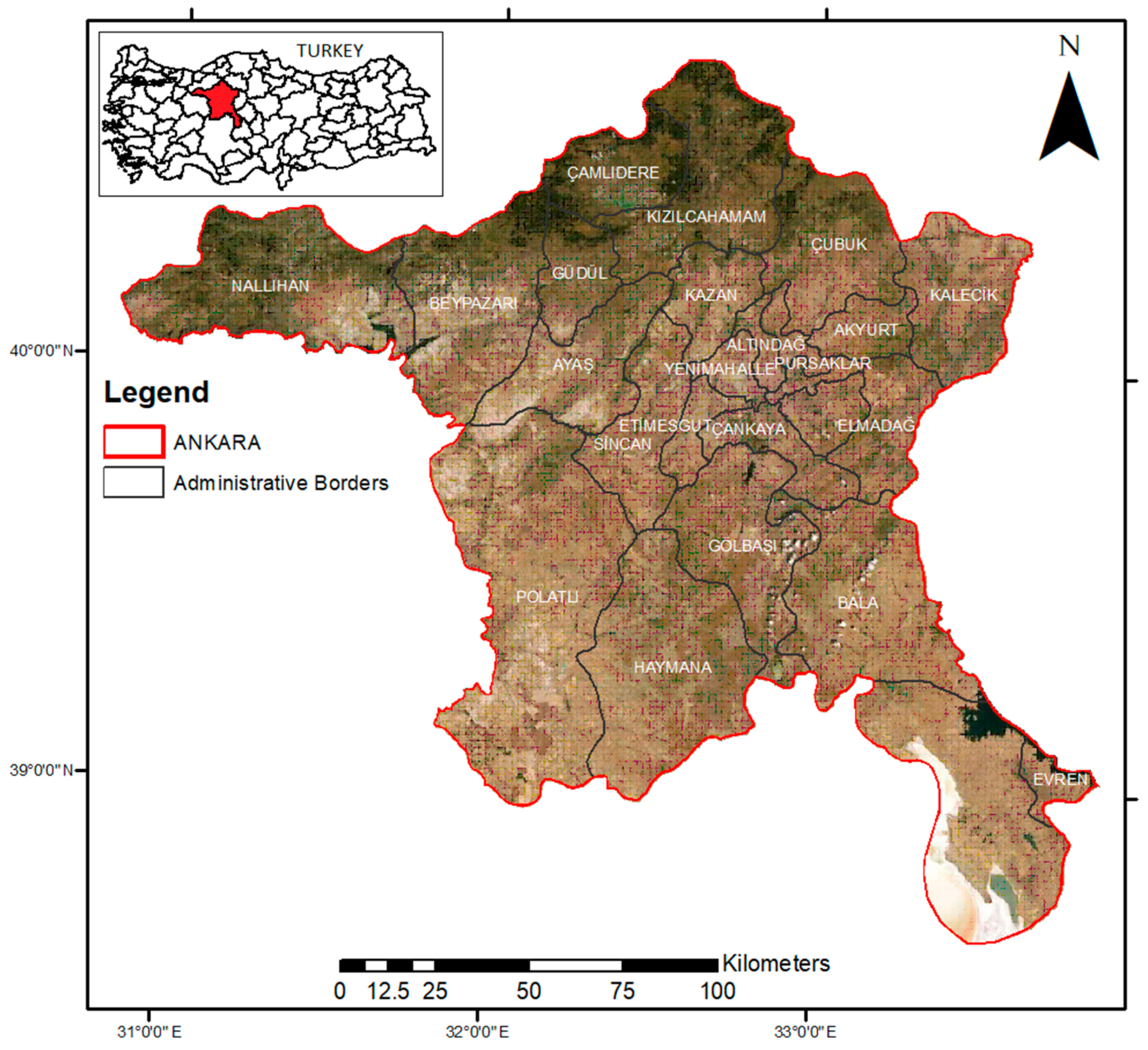
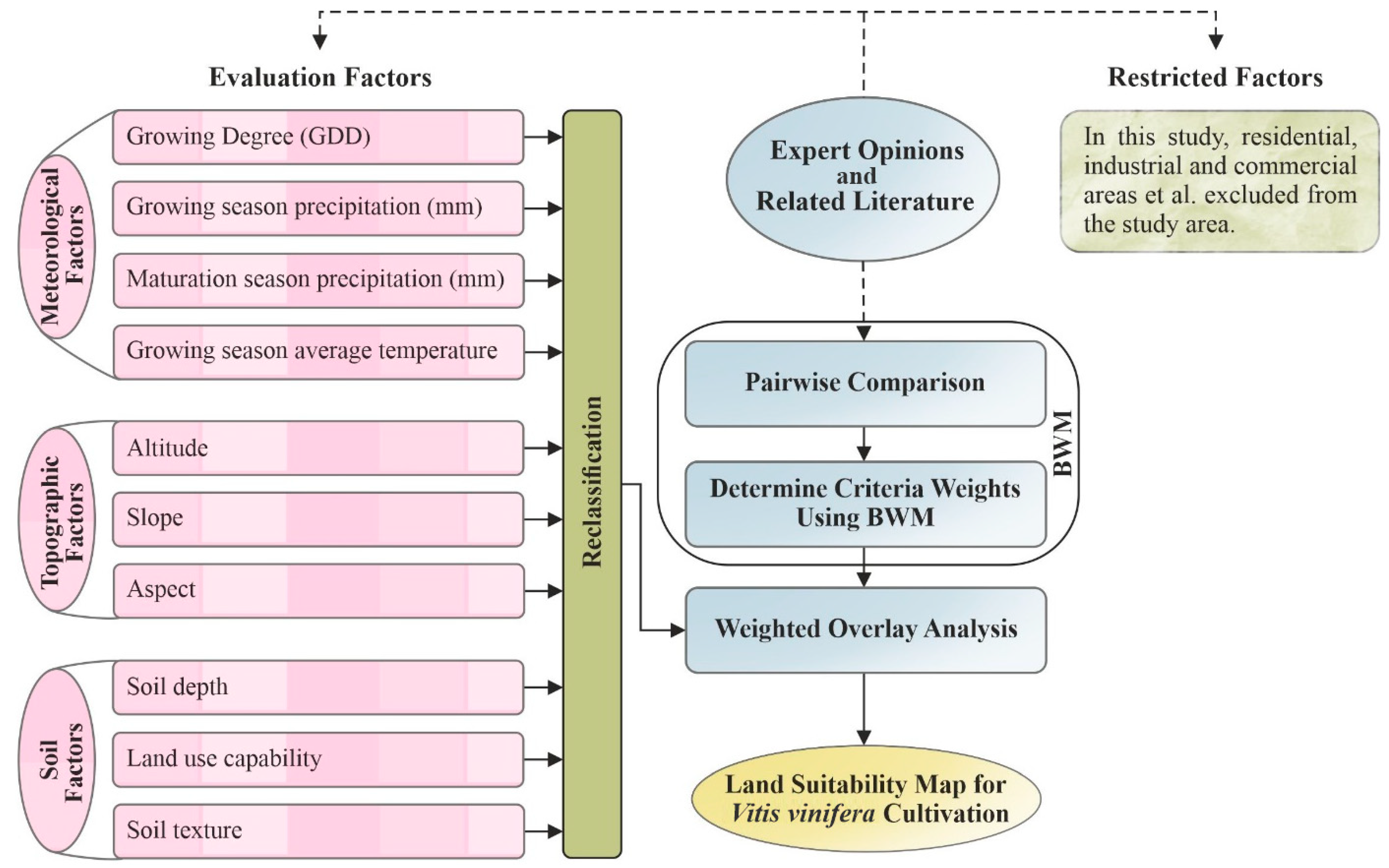
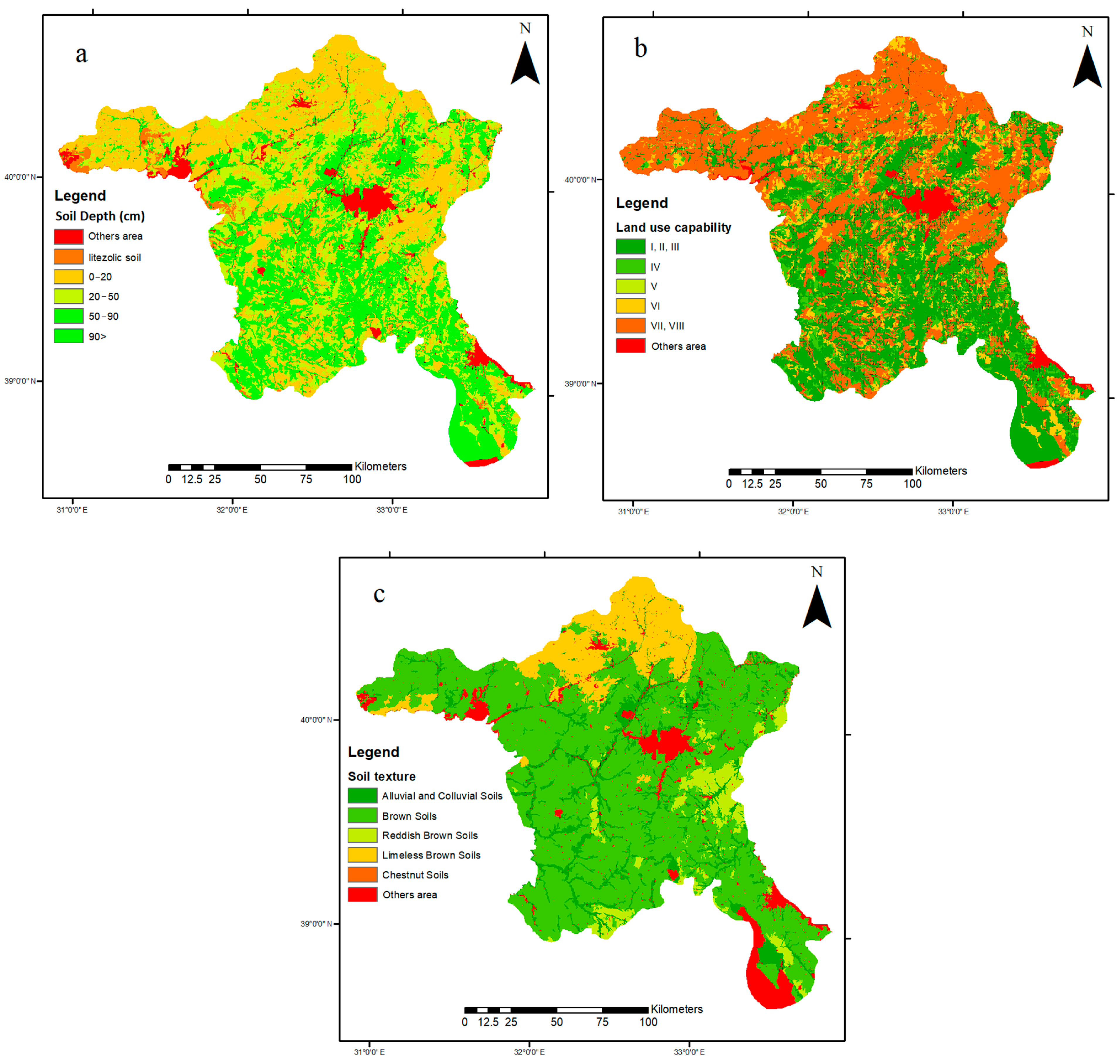
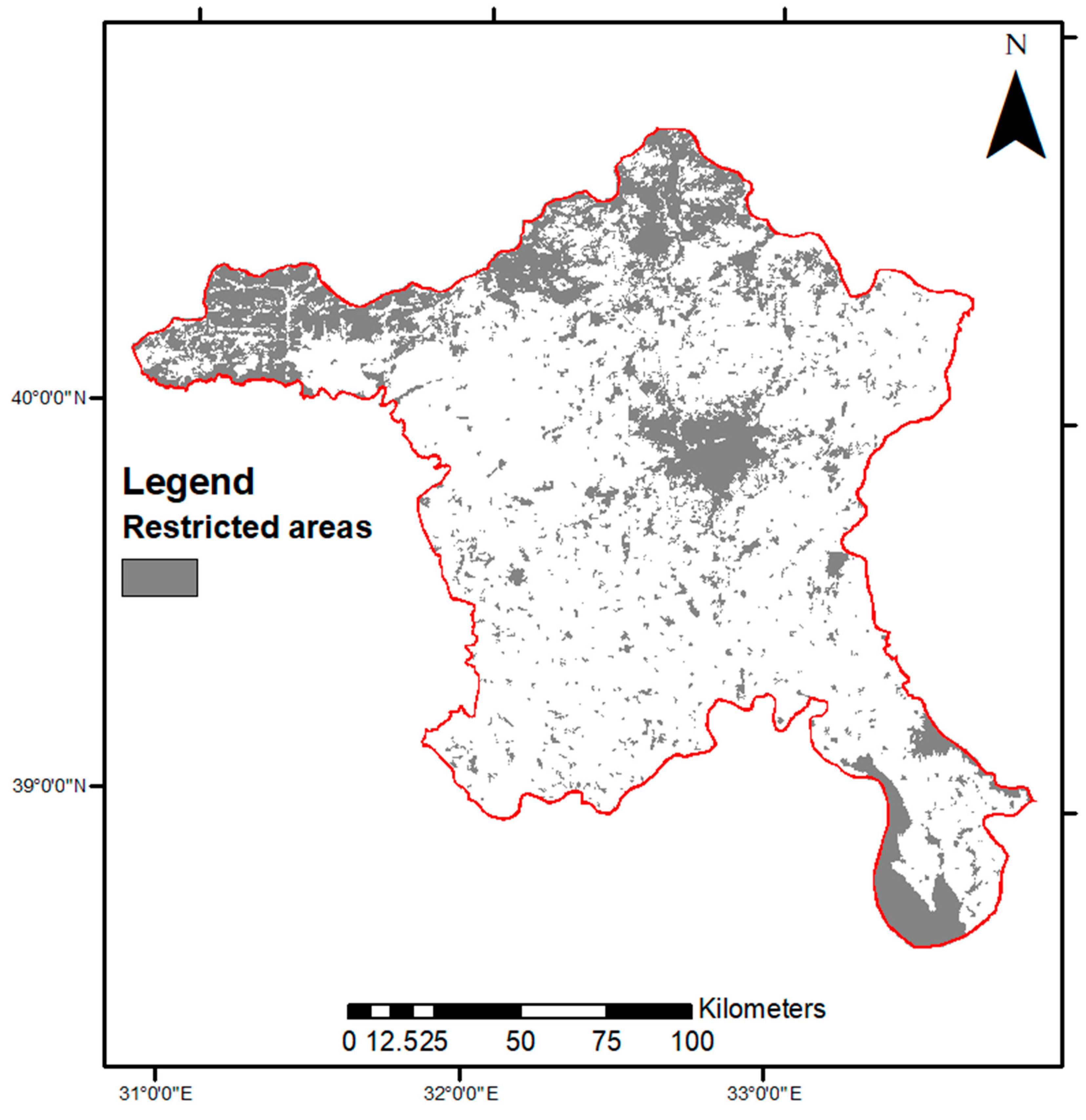

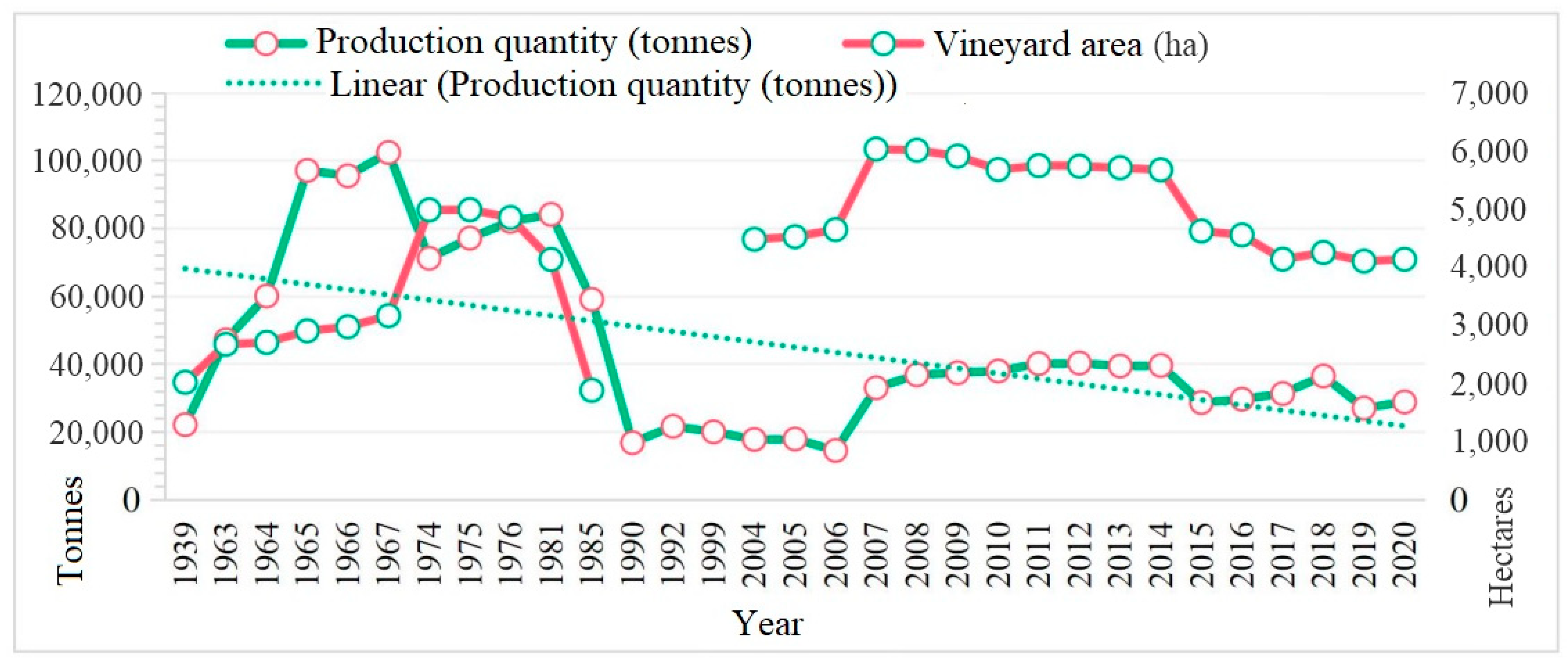
| Ankara | Jan | Feb | Mar | Apr | May | June | July | August | Sep | Oct | Nov | Dec | Avg. |
|---|---|---|---|---|---|---|---|---|---|---|---|---|---|
| Average temperature (°C) | 0.2 | 1.7 | 5.7 | 11.2 | 16.0 | 20.0 | 23.4 | 23.4 | 18.9 | 13.2 | 7.2 | 2.5 | 11.9 |
| Average max. temperature (°C) | 4.2 | 6.5 | 11.5 | 17.4 | 22.4 | 26.7 | 30.3 | 30.4 | 26.1 | 20.0 | 13.0 | 6.5 | 17.9 |
| Average min. temperature (°C) | −3.3 | −2.3 | 0.7 | 5.3 | 9.7 | 12.9 | 15.8 | 16.0 | 11.8 | 7.2 | 2.5 | −0.8 | 6.3 |
| Goal | Obj. | Weight | CR | Criteria | Weight | CR | Sub-Criteria | Weight | CR | ∑Weight |
|---|---|---|---|---|---|---|---|---|---|---|
| LAND SUITABILITY for VITIS VINIFERA | Meteorological Factors | 0.49 | 0.046 | Growing degree days (GDD) | 0.54 | 0.072 | <900 | 0.00 | 0.077 | 0.000 |
| 900–1200 | 0.04 | 0.011 | ||||||||
| 1200–1500 | 0.50 | 0.132 | ||||||||
| 1500–1800 | 0.34 | 0.090 | ||||||||
| 1800–2500 | 0.12 | 0.032 | ||||||||
| Growing season precipitation (mm) | 0.05 | <150 | 0.03 | 0.079 | 0.001 | |||||
| 150–200 | 0.06 | 0.001 | ||||||||
| 200–250 | 0.10 | 0.002 | ||||||||
| 250–300 | 0.30 | 0.007 | ||||||||
| 300–350 | 0.51 | 0.013 | ||||||||
| Maturation season precipitation (mm) | 0.22 | <150 | 0.49 | 0.087 | 0.053 | |||||
| 150–200 | 0.26 | 0.028 | ||||||||
| 200–250 | 0.14 | 0.015 | ||||||||
| 250–300 | 0.08 | 0.008 | ||||||||
| 300–350 | 0.03 | 0.003 | ||||||||
| Annual precipitation (mm) | 0.06 | <400 | 0.03 | 0.090 | 0.001 | |||||
| 400–500 | 0.06 | 0.002 | ||||||||
| 500–550 | 0.14 | 0.004 | ||||||||
| 550–600 | 0.27 | 0.008 | ||||||||
| 600–700 | 0.51 | 0.015 | ||||||||
| Growing season average temperature (°C) | 0.13 | <13 | 0.00 | 0.083 | 0.000 | |||||
| 13–15 | 0.09 | 0.006 | ||||||||
| 15–17 | 0.20 | 0.013 | ||||||||
| 17–21 | 0.71 | 0.045 | ||||||||
| Topographic Factors | 0.20 | Altitude | 0.06 | 0.091 | 240–750 | 0.03 | 0.094 | 0.000 | ||
| 750–1000 | 0.06 | 0.001 | ||||||||
| 1000–1200 | 0.14 | 0.002 | ||||||||
| 1200–1500 | 0.31 | 0.004 | ||||||||
| 1500–2075 | 0.46 | 0.006 | ||||||||
| Slope (%) | 0.30 | 0–5 | 0.27 | 0.096 | 0.016 | |||||
| 0–15 | 0.57 | 0.034 | ||||||||
| 15–25 | 0.12 | 0.007 | ||||||||
| 25–30 | 0.04 | 0.003 | ||||||||
| >30 | 0.00 | 0.000 | ||||||||
| Aspect | 0.63 | Flat | 0.10 | 0.096 | 0.013 | |||||
| South, southeast, southwest | 0.63 | 0.079 | ||||||||
| East, west | 0.19 | 0.024 | ||||||||
| Northeast, northwest | 0.04 | 0.005 | ||||||||
| North | 0.04 | 0.005 | ||||||||
| Soil Factors | 0.31 | Soil depth | 0.41 | 0.025 | 0–20 | 0.00 | 0.071 | 0.000 | ||
| 20–50 | 0.07 | 0.009 | ||||||||
| 50–90 | 0.15 | 0.020 | ||||||||
| >90 | 0.78 | 0.099 | ||||||||
| Land use capability | 0.12 | I–III | 0.74 | 0.023 | 0.028 | |||||
| IV | 0.10 | 0.004 | ||||||||
| V | 0.08 | 0.003 | ||||||||
| VI | 0.07 | 0.003 | ||||||||
| VII–VIII | 0.00 | 0.000 | ||||||||
| Soil texture | 0.48 | Alluvial and colluvial | 0.46 | 0.066 | 0.069 | |||||
| Brown | 0.26 | 0.039 | ||||||||
| Reddish-brown | 0.15 | 0.023 | ||||||||
| Limeless-brown | 0.08 | 0.012 | ||||||||
| Chestnut | 0.04 | 0.006 |
Disclaimer/Publisher’s Note: The statements, opinions and data contained in all publications are solely those of the individual author(s) and contributor(s) and not of MDPI and/or the editor(s). MDPI and/or the editor(s) disclaim responsibility for any injury to people or property resulting from any ideas, methods, instructions or products referred to in the content. |
© 2023 by the authors. Licensee MDPI, Basel, Switzerland. This article is an open access article distributed under the terms and conditions of the Creative Commons Attribution (CC BY) license (https://creativecommons.org/licenses/by/4.0/).
Share and Cite
Uyan, M.; Janus, J.; Ertunç, E. Land Use Suitability Model for Grapevine (Vitis vinifera L.) Cultivation Using the Best Worst Method: A Case Study from Ankara/Türkiye. Agriculture 2023, 13, 1722. https://doi.org/10.3390/agriculture13091722
Uyan M, Janus J, Ertunç E. Land Use Suitability Model for Grapevine (Vitis vinifera L.) Cultivation Using the Best Worst Method: A Case Study from Ankara/Türkiye. Agriculture. 2023; 13(9):1722. https://doi.org/10.3390/agriculture13091722
Chicago/Turabian StyleUyan, Mevlut, Jarosław Janus, and Ela Ertunç. 2023. "Land Use Suitability Model for Grapevine (Vitis vinifera L.) Cultivation Using the Best Worst Method: A Case Study from Ankara/Türkiye" Agriculture 13, no. 9: 1722. https://doi.org/10.3390/agriculture13091722
APA StyleUyan, M., Janus, J., & Ertunç, E. (2023). Land Use Suitability Model for Grapevine (Vitis vinifera L.) Cultivation Using the Best Worst Method: A Case Study from Ankara/Türkiye. Agriculture, 13(9), 1722. https://doi.org/10.3390/agriculture13091722








